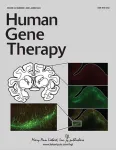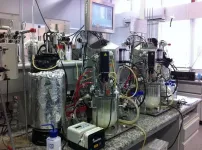(Press-News.org) A subset of white blood cells, known as myeloid cells, can harbor HIV in people who have been virally suppressed for years on antiretroviral therapy, according to findings from a small study supported by the National Institutes of Health. In the study, researchers used a new quantitative method to show that HIV in specific myeloid cells—short-lived monocytes and longer-lived monocyte-derived macrophages—can be reactivated and infect new cells. The findings, published in Nature Microbiology, suggest that myeloid cells contribute to a long-lived HIV reservoir, making these cells an important but overlooked target in efforts to eradicate HIV.
“Our findings challenge the prevailing narrative that monocytes are too short-lived to be important in cure efforts,” said study author Rebecca Veenhuis, Ph.D., an assistant professor of molecular and comparative pathobiology and of neurology at Johns Hopkins University School of Medicine, Baltimore. “Yes, the cells are short-lived, but our follow-up data show that HIV can persist in monocytes over several years in people who are virally suppressed. The fact that we can detect HIV in these cells over such a long period suggests something is keeping the myeloid reservoir going.”
The study, led by Veenhuis and colleagues at Johns Hopkins University School of Medicine, was supported by the National Institute of Mental Health, the National Institute of Allergy and Infectious Diseases, and the National Institute on Drug Abuse, all part of NIH.
Antiretroviral medications are effective in treating HIV because they prevent the virus from infecting new cells and multiplying. However, HIV may still exist in cells that are in a resting, or latent, state, creating an HIV reservoir. CD4 T cells, a type of white blood cell, are the most well-studied HIV reservoir. Identifying HIV reservoirs is critical to cure efforts, as latent HIV can be reactivated if people stop taking antiretroviral medications.
Monocytes are immune cells that circulate in the blood for about 3 days before traveling to tissue in various parts of the body, including the brain, where they can mature into macrophages. To date, it has not been clear whether latent HIV in these cells can become active again and infect other cells.
“What’s really important in the long run is understanding how monocytes contribute to the tissue macrophage reservoir,” explained Janice Clements, Ph.D., senior author on the study and professor of molecular and comparative pathobiology at Johns Hopkins University School of Medicine. “If monocytes can carry virus to the brain, or lung, or another part of the body and infect resident macrophages that are self-renewing and live almost indefinitely, that’s a real problem.”
In the study, Veenhuis, Clements, and colleagues first measured HIV DNA in myeloid cells in a sample of 30 participants with HIV, all of whom were virally suppressed and had been on antiretroviral therapy for at least 5 years. They found detectable levels of HIV genetic material in monocytes and macrophages, though the levels were much lower than those observed in CD4 T cells. In some participants, the HIV genetic material found in monocytes was intact, which suggests it may be capable of infecting other cells if reactivated.
They then used the new quantitative method they developed to directly measure viral spread from HIV found in myeloid cells. The researchers isolated monocytes from blood samples taken from 10 participants and nurtured the monocytes in cultures that contained antiretroviral drugs, to replicate the participants’ baseline physical state. After the monocytes differentiated into macrophages, the researchers introduced an immune activating agent and then added fresh white bloods cells to allow for the virus to spread to new cells.
The researchers collected samples from the cell cultures several times over the next 12 days. They included checkpoints throughout the process to ensure that infected CD4 T cells did not interfere with their measurements.
The results showed that cultures from five of the 10 participants had detectable HIV genetic material in monocyte-derived macrophages that could be reactivated to infect other cells and produce more virus. The participants who had these reactivatable reservoirs of HIV in monocyte-derived macrophages had higher overall levels of HIV DNA material.
Follow-up data from three participants showed that this reservoir can be long-lived, harboring latent HIV for months to several years. These reservoirs were stable and could be reactivated over time, indicating that monocyte-derived macrophages could contribute to viral rebound if antiretroviral treatment is disrupted.
The researchers note that this study is small and larger studies with more diverse participant pools will be essential to accurately estimate the proportion of people who have latent HIV in myeloid cells. Investigating the mechanisms that replenish the monocyte reservoir over time is a critical next step in this research.
“These findings underscore the importance of broadening the scope of HIV cure efforts,” said Joshua A. Gordon, M.D., Ph.D., director of the National Institute of Mental Health. “Shifting away from a sole focus on CD4 T cells to thinking about CD 4 T cells and myeloid cells together, in context, will propel the field toward more promising strategies for eradicating HIV.”
Reference
Veenhuis, R. T., Abreu, C. M., Costa, P. A. G., Ferreira, E. A., Ratliff, J., Pohlenz, L., Shirk, E. N., Rubin, L. H., Blankson, J. N., Gama, L., & Clements, J. E. (2023). Monocyte-derived macrophages contain long-lived latent HIV reservoirs. Nature Microbiology. https://doi.org/10.1038/s41564-023-01349-3
Grants
MH127981, MH113512-03S1, MH075673, AI131306, AI127142, AI094189, DA050529
###
About the National Institute of Mental Health (NIMH): The mission of NIMH is to transform the understanding and treatment of mental illnesses through basic and clinical research, paving the way for prevention, recovery, and cure. For more information, visit the NIMH website.
About the National Institutes of Health (NIH): NIH, the nation's medical research agency, includes 27 Institutes and Centers and is a component of the U.S. Department of Health and Human Services. NIH is the primary federal agency conducting and supporting basic, clinical, and translational medical research, and is investigating the causes, treatments, and cures for both common and rare diseases. For more information about NIH and its programs, visit the NIH website.
NIH…Turning Discovery Into Health®
END
American Geophysical Union
Press Release 23-11
27 March 2023
For Immediate Release
This press release is available online at: https://news.agu.org/press-release/the-greenland-ice-sheet-is-close-to-a-melting-point-of-no-return/
AGU press contact:
Rebecca Dzombak, +1 (202) 777-7492, news@agu.org (UTC-4 hours)
Contact information for the researchers:
Dennis Höning, Potsdam Institute for Climate Impact Research, dennis.hoening@pik-potsdam.de (UTC+1 hour)
WASHINGTON — The Greenland Ice Sheet covers 1.7 million ...
New simulation combines emissions with weather and chemistry in an air-quality model
First neighborhood-scale simulation of its kind focused on Chicago tracks air quality hour by hour across areas as small as 1.3 kilometers-sized blocks
Simulation can show how pollutants move across space and time throughout the city and surrounding areas
Air pollution along highways is consistently worse than other areas, regardless of season or time of day
EVANSTON, Ill. — If you live along one of the major interstate highways running through Chicago or directly next to Lake Michigan, you are regularly exposed to more air pollution than ...
TAMPA, Fla. – Immunotherapies have greatly improved the outcomes of many patients with melanoma. But there is still a need for new approaches for the subset of patients who do not respond well to this type of therapy. Moffitt Cancer Center researchers are looking at new targets to help inhibit tumor development and promote antitumor immunity, one being the STING signaling pathway. In a new article published in Nature Communications, a team of Moffitt and University of Miami Miller School of Medicine investigators demonstrate that targeting the STING pathway with a combination strategy ...
In addition to an antigen, many vaccines also contain substances, called adjuvants, which stimulate the immune system. By using computer-aided molecular design and machine learning, a Chinese research team has now developed two novel broad-spectrum adjuvants that can significantly amplify the immune response to vaccines. As reported in the journal Angewandte Chemie, they were able to enhance the effectiveness of immunization against certain forms of cancer in animal models.
Adjuvants amplify and prolong the effect of vaccine immunizations. Aluminum salts have been successfully used ...
ITHACA, N.Y. – An international team of astronomers has found the atmospheric compositions of giant planets out in the galaxy do not fit our own solar system trend.
Using NASA’s James Webb Space Telescope (JWST), the researchers discovered that the atmosphere of exoplanet HD149026b, a ‘hot Jupiter’ orbiting a star comparable to our sun, is super-abundant in the heavier elements carbon and oxygen – far above what scientists would expect for a planet of its mass.
These findings, published in “High atmospheric metal enrichment for a Saturn-mass ...
When studying the brain, researchers are just beginning to use a method known as voltage imaging to track neural activity in the living animal. While this approach is a promising way to better understand neuron firing, behavior, and cognition, there are limitations and risk factors. The practice requires putting a lot of light into the brain (which can lead to overheating) and only has the capacity to image ten neurons at a time.
New research from Jerry Chen, a Boston University College of Arts & Sciences assistant professor of biology, and collaborators aims to address these challenges. Published today in Nature Methods, ...
Researchers at Rochester Institute of Technology are investigating the combined physical effects of heat, chemical reactions, and seismic activity on concrete lining structures used to dispose of nuclear waste. Results from the work could improve nuclear waste infrastructure designs, better long-term safety management, and refine strategies to meet climate change targets.
Lu Sun, a professor in RIT’s College of Engineering Technology (CET), received a grant of nearly $500,000 from the Nuclear Regulatory Commission for “High temperature and seismic response of concrete lining structures and clay in nuclear waste disposal.” ...
An international team of researchers has used NASA’s James Webb Space Telescope to measure the temperature of the rocky exoplanet TRAPPIST-1 b. The measurement is based on the planet’s thermal emission: heat energy given off in the form of infrared light detected by Webb’s Mid-Infrared Instrument (MIRI). The result indicates that the planet’s dayside has a temperature of about 500 kelvins (roughly 450 degrees Fahrenheit) and suggests that it has no significant atmosphere.
This is the first detection of any form of light emitted by an exoplanet as small and as cool as the rocky planets in our own solar system. The result ...
Providing an overview of the submissions process and examples of U.S. Food and Drug Administration (FDA) applications for Orphan Drug Designation (ODD) and Rare Pediatric Disease Designation (RPDD), a new article can help developers of gene therapies for rare genetic diseases. The article is published in the peer-reviewed journal Human Gene Therapy. Click here to read the article now.
Anne Pariser and Elizabeth Ottinger, from the National Center for Advances in Translational Sciences (NCATS), National Institutes of Health, and coauthors, describe the ODD and RPDD programs, which provide financial incentives for the development of ...
A Brazilian study paves the way to increased efficiency of second-generation (2G) ethanol production based on the discovery of novel targets for metabolic engineering in a more robust strain of industrial yeast. An article on the study is published in the journal Scientific Reports.
The databases compiled by the authors are at the disposal of the scientific community in the repository of the State University of Campinas (UNICAMP), which is a member of the Dataverse Project, an international collaborative initiative supported by FAPESP.
First-generation (1G) ethanol is produced from sources rich in carbohydrates ...




